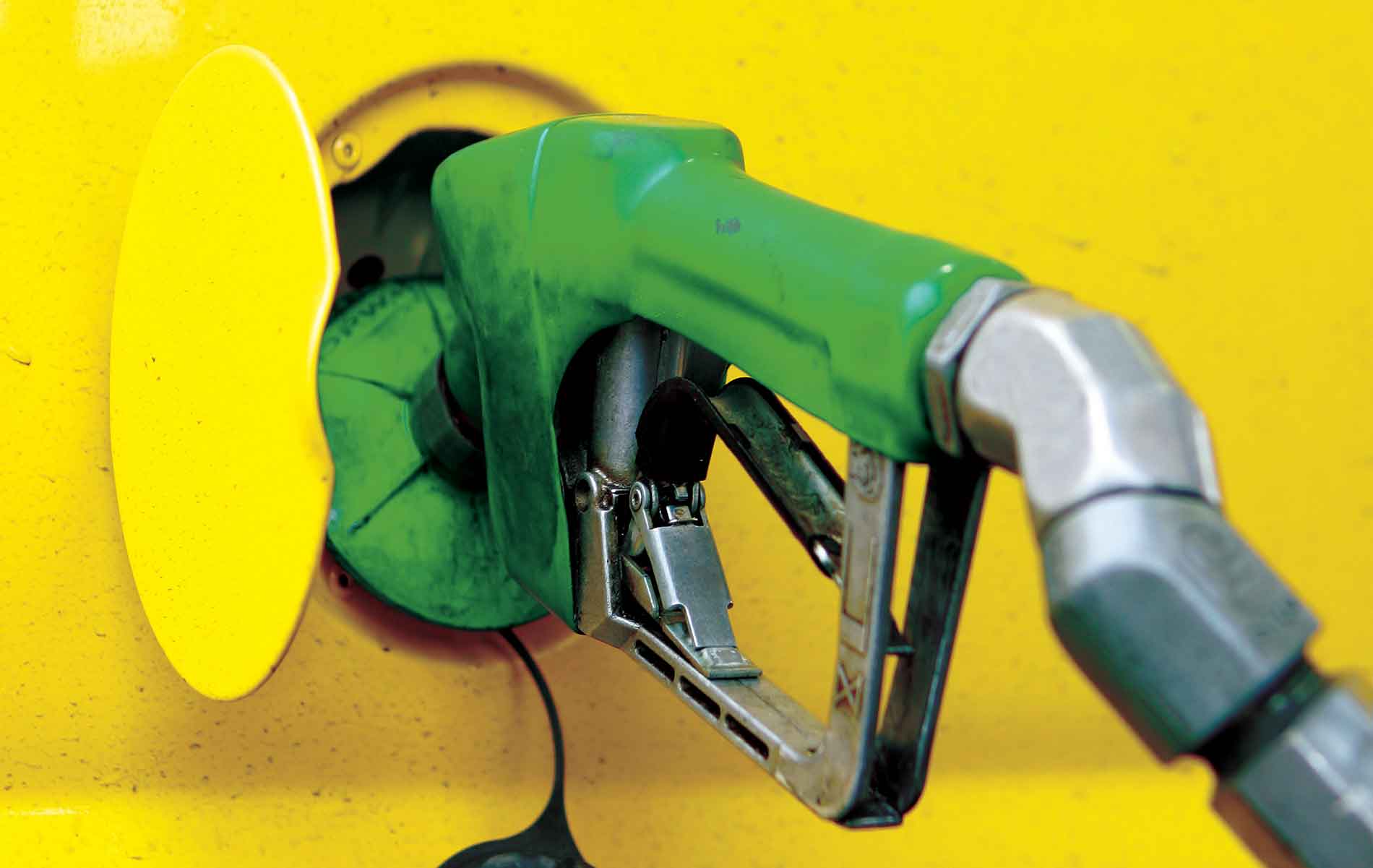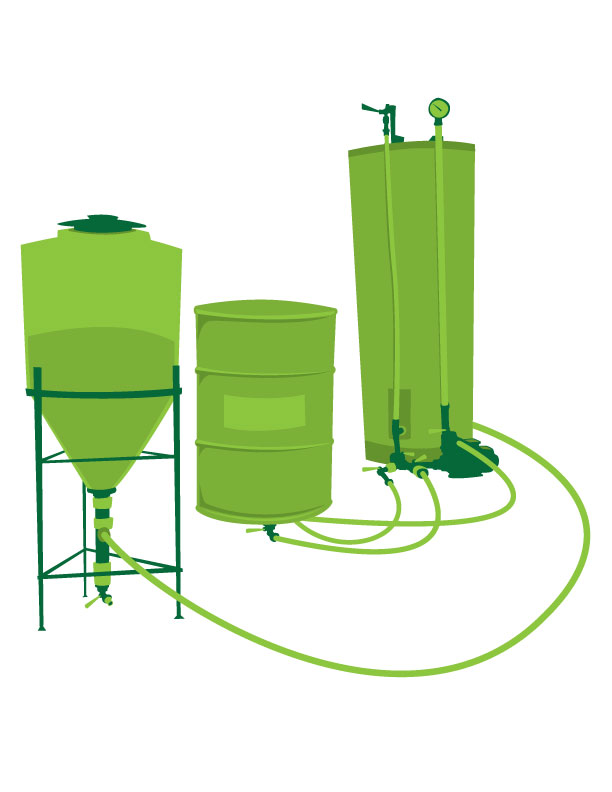
vie_magazine_biofuel_hero
Brewing Biodiesel in Point Washington
Written by Tim Dutrow | Illustration by Eric Shepard
With rising fuel costs and global warming concerns, some locals may be thinking, “As a resident of Northwest Florida, what can I do to help make a difference?” or “I don’t live in a big city and therefore do not have access to resources in my area to even consider an alternative fuel for my car.” If people are truly interested in beginning to make a change in order to help sustain Mother Earth, there is at least one viable option to consider—biodiesel.
I was first introduced to biodiesel as an alternative fuel in the spring of 2006. The possibility of fueling my vehicle with a non-petroleum-based, renewable fuel provided me with an exciting avenue to pursue and taking conservation matters into my own hands. Biodiesel is considered a renewable fuel because it is easily replaceable, unlike petroleum-based fuels. Many people believe that expensive or complicated modifications must be made to their cars in order for them to run efficiently on biodiesel. In my initial research, I quickly discovered that all diesel vehicles can run on 100% biodiesel, with no complicated conversion necessary. I am often asked what I did in order to “convert” my Volkswagen Jetta to be able to run on biodiesel, and I reply with a big smile and say, “Nothing!” The question is common because biodiesel is often confused with straight vegetable oil (SVO), another alternative biofuel, which requires costly conversions of diesel motors and fuel distribution systems.
What exactly is biodiesel? Technically, it is fatty acid methyl esters (FAME). I could provide a complicated chemical equation, but I do not wish to consume your time with chemistry; this is not an article for a science monthly magazine. In simpler terms, FAME is French fry oil (or some variety of vegetable oil) that has been converted by transesterification. This process takes place through a chemical reaction after adding methanol and potassium hydroxide to heated vegetable oil. This conversion process is necessary in order to remove the glycerin molecules from the fatty acids; in effect, this “thins” the vegetable oil in order to create a fuel that is useable and suitable for combustion engines—specifically, diesel engines.
How can a person obtain biodiesel fuel? There are a couple of different options: one is to use a biodiesel supplier, and another is to “brew” it; I do the latter with a homemade transesterification processor right here in historic Point Washington, Florida. Some people obtain a tremendous sense of satisfaction from distilling their own wine or beer; I feel the same fulfillment from making my own fuel.
Some people obtain a tremendous sense of satisfaction from distilling their own wine or beer; I feel the same fulfillment from making my own fuel.
In some ways, I find brewing biodiesel to be similar to making wine and beer, but the equipment and quantities are on a larger scale to match the consumption demand; cars are considerably “thirstier” than people.
Biodiesel can vary in color (light to dark amber) depending upon the source of the feedstock (source oil). Similarly, beer will vary in color depending on the source of the hops used in it. Additionally, similar to beer (and wine), the quality of the biodiesel has a direct correlation to the care the brewer takes during the process; time and patience are necessary in order to brew a good product. With a little research, an educational seminar (if possible), and a nominal financial investment, a person can build his/her own biodiesel brewer. Despite minor toxin hazards, it is quite safe; biodiesel fuel is not volatile like gasoline. In fact, it will not ignite with a match. Although eliminating petroleum dependency for my transportation needs remained my primary reason for making biodiesel, I found that brewing my own biodiesel has also dramatically cut my fuel costs.
Home brewing biodiesel fuel is not recommended for people who do not desire to “get their hands dirty” (harvesting used vegetable oil at your local restaurant requires this). Contacting a biodiesel supplier would be a wiser choice for these people. With the increasing demand for alternative fuels, sources for biodiesel are beginning to grow. Some fuel stations or depots actually offer biodiesel alongside the petroleum-based options. The more a specific technology is developed and accepted, the less expensive it usually becomes in the future. In the United States, the cost of biodiesel is competitive with its conventional counterpart; in some countries, it is less expensive than petroleum-based fuel. The American biodiesel industry is currently growing at an astounding rate of 20-30% per year according to a recent story in USA Today. As a result, more biodiesel suppliers will be established in the near future. Some suppliers even make “house calls,” delivering the biodiesel to a private storage tank that the consumer supplies. T-Gill Fuels of Pensacola is one such supplier, and a new plant is coming soon to the Mossy Head area.
Questions may arise, such as “What if I am on the road and can’t find a biodiesel fuel source?” Biodiesel users can simply fill their fuel tanks with conventional petroleum diesel. Biodiesel can be blended at any ratio. Being able to use petroleum diesel as well as biodiesel is one of the great benefits of this alternative fuel. I am proud to say that in the last two years, I have fueled my Jetta with petroleum diesel only once. However, if petroleum diesel is used on a regular basis, the fuel filter will need to be changed more often than when using only biodiesel. This alternative fuel tends to loosen petro-contaminants from the filter, and these particles are not desired in engines.
This fuel is also better for the environment; it burns cleaner, giving off fewer pollutants, and it is biodegradable.
The biodiesel industry is ever changing and increasing in popularity. Technology and manufacturers are beginning to embrace it at a growing rate. For example, Volkswagen and Scania are telling their European customers that they welcome fueling their cars with biodiesel, but it may take longer for that mentality to take hold in the United States. In actuality, biodiesel is better for engines because it has more “lubricity,” reducing some engine wear. This fuel is also better for the environment; it burns cleaner, giving off fewer pollutants, and it is biodegradable. Additionally, with the automobile industry improving engine efficiency and aerodynamics, diesel-powered cars that are capable of attaining 150 mpg are emerging onto the market (such as the German-designed Loremo, which is due for production next year in Germany and in 2010 in the United States). As more efficient automobiles, similar to the Loremo, become prominent in the relatively near future, air pollutants and dependency on petroleum-based fuels can be substantially reduced.
However, in order for the biodiesel industry to strive and maintain its viability in the marketplace, the feedstock must be both environmentally responsible and sustainable. (Feedstock is the source from which the oil is harvested in order to produce biodiesel.) Currently, most sources for biodiesel are also shared with food crops. This makes it vitally important that the biodiesel industry implement sustainable practices that do not promote the clearing of forests in order to produce feedstock. Other non-food resources for fuel are gaining traction in this industry, such as algae and biomass. Current technology is approaching the ability to harvest 4,000 gallons of oil per acre through the farming of algae, whereas soybeans produce only 50 gallons of oil per acre. This technology not only supports domestic farmers but also discourages deforestation around the globe. Society appears to demand a simpler solution for all concerns, like taking a single pill. Using algae as a practical stock source is about 5 to 10 years away. This fuel source must be used in a responsible manner because it may have potential adverse effects on the natural environment. Biodiesel is no panacea, just one small, yet important, piece to the overall puzzle. Conservation through education and lifestyle changes are vital. Everyone holds a piece to this puzzle—that we call the world.
If you are interested in making a difference to conserving our world’s natural resources and joining the alternative fuel revolution, here are some suggested research sources that I highly recommend: Piedmont Biofuels biofuels.coop. Piedmont has a biodiesel curriculum available for download (free). I also highly recommend the book Biodiesel, Basics and Beyond written by William H. Kemp. My thirst for biodiesel has taken hold! Has yours?
— V —
Share This Story!
KEEP UP WITH THE LATEST STORIES FROM VIE

















































































































































